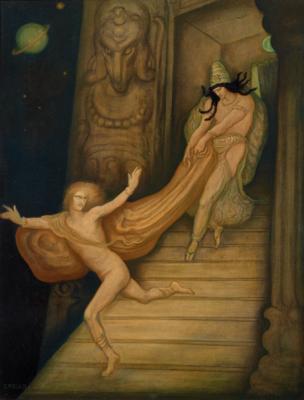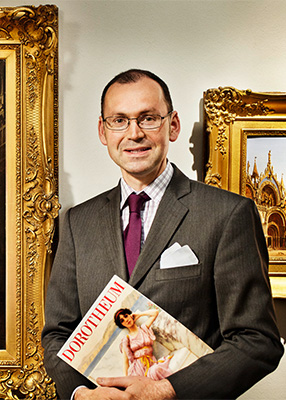Salomon-Léon Sarluis, called Léonard Sarluis

(The Hague 1874–1949 Paris)
Joseph and Potiphar’s Wife, signed Sarluis, oil on canvas, 65 x 50 cm, framed
Salomon-Léon Sarluis was born in 1874 to Léon Sarluis, an antiquarian from The Hague. His mother directed him towards artistic studies, encouraging him to attend the Ecole des Beaux-Arts in The Hague from 1891 to 1893. He moved to Paris, a city he already knew from having stayed there with his parents on several occasions between 1887 and 1889. In the capital, he became linked to the Symbolist circles led by the novelist and art critic Josephin Péladan, who organised the Salon de la Rose+Croix (1892-1897) which included the most famous contemporary Franco-Belgian artists, such as Jean Delville, Armand Point, Xavier Mellery, Alphonse Osbert, Fernand Knopff and Carlos Schwabe. They were inspired by occultism and bound by the precise aesthetic ideal of androgynous beauty formulated by Péladan.
It is the biblical episode of Joseph and Potiphar’s wife (Genesis 39:6-20), which tells of the rich Egyptian man’s wife’s attempt to seduce the young Hebrew slave: “Now one day he went into the house to do his work, while none of the servants were there. She seized him by the robe, saying, ‘Join me!’ But he left his robe in her hands, fled and went out”.
The canvas is steeped with references and distils the themes dear to Symbolist painting: the androgynous figure, the temple as a place of initiation, the night sky with the planet Saturn and the statue of the Egyptian deity Banebdjedet in the form of a goat.
Esperto: Gautier Gendebien
 Gautier Gendebien
Gautier Gendebien
+39-334-777 1603
Gautier.Gendebien@dorotheum.it
08.11.2022 - 17:00
- Stima:
-
EUR 7.000,- a EUR 10.000,-
Salomon-Léon Sarluis, called Léonard Sarluis
(The Hague 1874–1949 Paris)
Joseph and Potiphar’s Wife, signed Sarluis, oil on canvas, 65 x 50 cm, framed
Salomon-Léon Sarluis was born in 1874 to Léon Sarluis, an antiquarian from The Hague. His mother directed him towards artistic studies, encouraging him to attend the Ecole des Beaux-Arts in The Hague from 1891 to 1893. He moved to Paris, a city he already knew from having stayed there with his parents on several occasions between 1887 and 1889. In the capital, he became linked to the Symbolist circles led by the novelist and art critic Josephin Péladan, who organised the Salon de la Rose+Croix (1892-1897) which included the most famous contemporary Franco-Belgian artists, such as Jean Delville, Armand Point, Xavier Mellery, Alphonse Osbert, Fernand Knopff and Carlos Schwabe. They were inspired by occultism and bound by the precise aesthetic ideal of androgynous beauty formulated by Péladan.
It is the biblical episode of Joseph and Potiphar’s wife (Genesis 39:6-20), which tells of the rich Egyptian man’s wife’s attempt to seduce the young Hebrew slave: “Now one day he went into the house to do his work, while none of the servants were there. She seized him by the robe, saying, ‘Join me!’ But he left his robe in her hands, fled and went out”.
The canvas is steeped with references and distils the themes dear to Symbolist painting: the androgynous figure, the temple as a place of initiation, the night sky with the planet Saturn and the statue of the Egyptian deity Banebdjedet in the form of a goat.
Esperto: Gautier Gendebien
 Gautier Gendebien
Gautier Gendebien
+39-334-777 1603
Gautier.Gendebien@dorotheum.it
|
Hotline dell'acquirente
lun-ven: 10.00 - 17.00
kundendienst@dorotheum.at +43 1 515 60 200 |
| Asta: | Dipinti dell’Ottocento |
| Tipo d'asta: | Asta in sala con Live Bidding |
| Data: | 08.11.2022 - 17:00 |
| Luogo dell'asta: | Wien | Palais Dorotheum |
| Esposizione: | 22.10. - 08.11.2022 |
